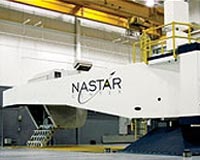 |
Bangalore, India (AFP) April 8, 2010 India plans to put a satellite into orbit using its indigenously built cryogenic rocket engine, marking another step in the nation's ambitious space programme, officials said. Cryogenic rocket motors, which use supercooled liquid fuel, have been built by only six countries or regions in the world, with India joining this club in October 2006, according to Indian space researchers. The engine will now be used to put a communications satellite into orbit with a launch scheduled for April 15, Indian Space Research Organisation (ISRO) chairman K. Radhakrishnan told reporters here on Wednesday. The launch will take place at India's space centre at Sriharikota on the coast of the eastern state of Andhra Pradesh, he said. India began its space programme in 1963 and has developed its own satellites and launch vehicles to cut dependence on other countries. Government funding of around 2.8 billion dollars has been secured for an attempt on its first manned space mission in 2016. In September, India's Chandrayaan-1 satellite discovered water on the moon, boosting its credibility among established space-faring nations.
Share This Article With Planet Earth
Related Links The latest information about the Commercial Satellite Industry
 NASTAR Center Announces 2010 Classes For Suborbital Scientists
NASTAR Center Announces 2010 Classes For Suborbital ScientistsSouthampton PA (SPX) Apr 08, 2010 Environmental Tectonics's National AeroSpace Training and Research (NASTAR) Center has announced the next Suborbital Scientist Training Program course dates as June 14, 15, 16 and August 2, 3, 4 of 2010. Course dates for sponsored groups are also set for the summer and fall of 2010. The NASTAR Suborbital Scientist Training Program provides space flight physiology training for prospective " ... read more |
|
| The content herein, unless otherwise known to be public domain, are Copyright 1995-2010 - SpaceDaily. AFP and UPI Wire Stories are copyright Agence France-Presse and United Press International. ESA Portal Reports are copyright European Space Agency. All NASA sourced material is public domain. Additional copyrights may apply in whole or part to other bona fide parties. Advertising does not imply endorsement,agreement or approval of any opinions, statements or information provided by SpaceDaily on any Web page published or hosted by SpaceDaily. Privacy Statement |